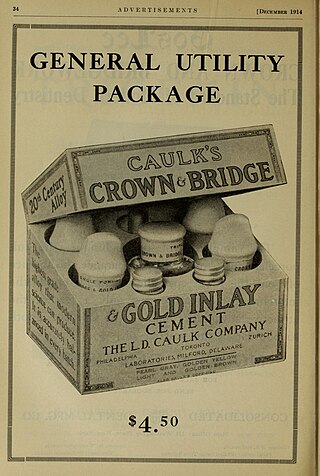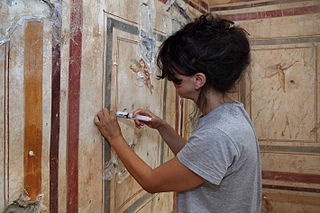A binder or binding agent is any material or substance that holds or draws other materials together to form a cohesive whole mechanically, chemically, by adhesion or cohesion.
More narrowly, binders are liquid or dough-like substances that harden by a chemical or physical process and bind fibres, filler powder and other particles added into it. Examples include glue, adhesive and thickening.
Examples of mechanical binders are bond stones in masonry and tie beams in timber framing.
Binders are loosely classified as organic (bitums, animal and plant glues, polymers) and inorganic (lime, cement, gypsum, liquid glass, etc.). These can be either metallic or ceramic as well as polymeric depending on the nature of the main material. For example, in the compound WC-Co (Tungsten Carbide used in cutting tools) Co constitutes the binding agent for the WC particles.
Based on their chemical resistance, binders are classified by the field of use: non-hydraulic (gypsum, air-cements, magnesia, hydrated lime), hydraulic (Roman cement, portland cement, hydraulic lime), acid-resistant (silicon fluoride cement, quartz cement), and autoclavable (harden at 170 to 300°С i.e. 8-16 atm pressure and, e.g., comprise CaSiO3 materials).
Some materials labeled as binders such as cement have a high compressive strength but low tensile strength and need to be reinforced with fibrous material or rebar if tension and shear forces will be applied.
Other binding agents such as resins may be tough and possibly elastic but can neither bear compressive nor tensile force. Tensile strength is greatly improved in composite materials consisting of resin as the matrix and fiber as a reinforcement. Compressive strength can be improved by adding filling material.
Binders hold together pigments and sometimes filling material to form paints, pastels, and other materials used for artistic and utilitarian painting. Materials include wax, linseed oil, natural gums such as gum arabic or gum tragacanth, methyl cellulose, or proteins such as egg white or casein. Glue is traditionally made by the boiling of hoofs, bones, or skin of animals and then mixing the hard gelatinous residue with water. Natural gum-based binders are made from substances extracted from plants. [1] Larger amounts of dry substance are added to liquid binders in order to cast or model sculptures and reliefs. [2]
In cooking, various edible thickening agents are used as binders. Some of them, e.g. tapioca flour, lactose, sucrose, microcrystalline cellulose, polyvinylpyrrolidone and various starches are also used in pharmacology in making tablets. Tablet binders include lactose powder, sucrose powder, tapioca starch (cassava flour) and microcrystalline cellulose.
In building construction, concrete uses cement as a binder. Asphalt pavement uses bitumen binder. Traditionally straw and natural fibres are used to strengthen clay in wattle-and-daub construction and in the building material cob which would otherwise become brittle after drying. Sand is added to improve compressive strength, hardness and reduce shrinkage. The binding property of clay is also used widely to prepare shaped articles (e.g. pots and vases) or to bind solid pieces (e.g. bricks).
In composite materials, epoxy, polyester or phenolic resins are common. In reinforced carbon–carbon, plastic or pitch resin is used as a source of carbon released through pyrolysis. Transite, hypertufa, papercrete and petecrete used cement as a binder.
In explosives, wax or polymers like polyisobutylene or styrene-butadiene rubber are often used as binders for plastic explosives. For polymer-bonded explosives, various synthetic polymers are used.
In rocket fuels, polybutadiene acrylonitrile copolymer was used in 1960-70's big solid-fuel booster rocket fuels.
Organic binders, designed to disintegrate by heat during baking, are used in sintering.
In the Classical World painters used materials like egg, wax, honey, lime, casein, linseed oil or bitumen as binders to mix with pigment in order to hold the pigment particles together in the formation of paint. [3] Egg-based tempera was especially popular in Europe from the Middle Ages until the early 16th century. [4] However, since that time, the binder of choice for paint has been oil. [5]

Adhesive, also known as glue, cement, mucilage, or paste, is any non-metallic substance applied to one or both surfaces of two separate items that binds them together and resists their separation.

Concrete is a composite material composed of aggregate bonded together with a fluid cement that cures to a solid over time. Concrete is the second-most-used substance in the world after water, and is the most widely used building material. Its usage worldwide, ton for ton, is twice that of steel, wood, plastics, and aluminium combined.

A cement is a binder, a chemical substance used for construction that sets, hardens, and adheres to other materials to bind them together. Cement is seldom used on its own, but rather to bind sand and gravel (aggregate) together. Cement mixed with fine aggregate produces mortar for masonry, or with sand and gravel, produces concrete. Concrete is the most widely used material in existence and is behind only water as the planet's most-consumed resource.

Paint is a material or mixture that, when applied to a solid material and allowed to dry, adds a film-like layer. As art, this is used to create an image or images known as a painting. Paint can be made in many colors and types. Most paints are either oil-based or water-based, and each has distinct characteristics.

A tablet is a pharmaceutical oral dosage form or solid unit dosage form. Tablets may be defined as the solid unit dosage form of medication with suitable excipients. It comprises a mixture of active substances and excipients, usually in powder form, that are pressed or compacted into a solid dose. The main advantages of tablets are that they ensure a consistent dose of medicine that is easy to consume.

Plaster is a building material used for the protective or decorative coating of walls and ceilings and for moulding and casting decorative elements. In English, "plaster" usually means a material used for the interiors of buildings, while "render" commonly refers to external applications. The term stucco refers to plasterwork that is worked in some way to produce relief decoration, rather than flat surfaces.

Styrene-butadiene or styrene-butadiene rubber (SBR) describe families of synthetic rubbers derived from styrene and butadiene. These materials have good abrasion resistance and good aging stability when protected by additives. In 2012, more than 5.4 million tonnes of SBR were processed worldwide. About 50% of car tires are made from various types of SBR. The styrene/butadiene ratio influences the properties of the polymer: with high styrene content, the rubbers are harder and less rubbery. SBR is not to be confused with the thermoplastic elastomer, styrene-butadiene block copolymer, although being derived from the same monomers.

A drying oil is an oil that hardens to a tough, solid film after a period of exposure to air, at room temperature. The oil hardens through a chemical reaction in which the components crosslink by the action of oxygen. Drying oils are a key component of oil paint and some varnishes. Some commonly used drying oils include linseed oil, tung oil, poppy seed oil, perilla oil, castor oil and walnut oil. The use of natural drying oils has declined over the past several decades, as they have been replaced by alkyd resins and other binders.
An excipient is a substance formulated alongside the active ingredient of a medication. They may be used to enhance the active ingredient’s therapeutic properties; to facilitate drug absorption; to reduce viscosity; to enhance solubility; to improve long-term stabilization ; or to add bulk to solid formulations that have small amounts of potent active ingredients. During the manufacturing process, excipients can improve the handling of active substances and facilitate powder flow. The choice of excipients depends on factors such as the intended route of administration, the dosage form, and compatibility with the active ingredient.

Casein paint, derived from milk casein, is a fast-drying, water-soluble medium used by artists.

A thickening agent or thickener is a substance which can increase the viscosity of a liquid without substantially changing its other properties. Edible thickeners are commonly used to thicken sauces, soups, and puddings without altering their taste; thickeners are also used in paints, inks, explosives, and cosmetics.

Hot-melt adhesive (HMA), also known as hot glue, is a form of thermoplastic adhesive that is commonly sold as solid cylindrical sticks of various diameters designed to be applied using a hot glue gun. The gun uses a continuous-duty heating element to melt the plastic glue, which the user pushes through the gun either with a mechanical trigger mechanism on the gun, or with direct finger pressure. The glue squeezed out of the heated nozzle is initially hot enough to burn and even blister skin. The glue is sticky when hot, and solidifies in a few seconds to one minute. Hot-melt adhesives can also be applied by dipping or spraying, and are popular with hobbyists and crafters both for affixing and as an inexpensive alternative to resin casting.
Gum base is the non-nutritive, non-digestible, water-insoluble masticatory delivery system used to carry sweeteners, flavors, and any other substances in chewing gum and bubble gum. It provides all the basic textural and masticatory properties of gum.

A luting agent is a dental cement connecting the underlying tooth structure to a fixed prosthesis. To lute means to glue two different structures together. There are two major purposes of luting agents in dentistry – to secure a cast restoration in fixed prosthodontics, and to keep orthodontic bands and appliances in situ.
Polymer concrete is a type of concrete that uses a polymer to replace lime-type cements as a binder. One specific type is epoxy granite, where the polymer used is exclusively epoxy. In some cases the polymer is used in addition to portland cement to form Polymer Cement Concrete (PCC) or Polymer Modified Concrete (PMC). Polymers in concrete have been overseen by Committee 548 of the American Concrete Institute since 1971.

Filler materials are particles added to binders to make a composite material. Filler materials improve specific properties or make the product cheaper.
Microcrystalline cellulose (MCC) is a term for refined wood pulp and is used as a texturizer, an anti-caking agent, a fat substitute, an emulsifier, an extender, and a bulking agent in food production. The most common form is used in vitamin supplements or tablets. It is also used in plaque assays for counting viruses, as an alternative to carboxymethylcellulose.

Paper chemicals designate a group of chemicals that are used for paper manufacturing, or modify the properties of paper. These chemicals can be used to alter the paper in many ways, including changing its color and brightness, or by increasing its strength and resistance to water. The chemicals can be defined on basis of their usage in the process.

The conservation and restoration of frescoes is the process of caring for and maintaining frescos, and includes documentation, examination, research, and treatment to insure their long-term viability, when desired.